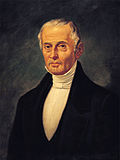Benito Juárez
Benito Pablo Juárez García (March 21, 1806 - July 18, 1872) was a Zapotec who served five terms (1858–1861 as interim), (1861–1865), (1865–1867), (1867–1871), and (1871–1872), as President of Mexico. During his presidency he outlawed the mistreatment of the Mexican Native Americans.
Benito Pablo Juárez García | |
|---|---|
 | |
| President of Mexico | |
| In office January 19, 1858 – July 18, 1872 | |
| Preceded by | Ignacio Comonfort |
| Succeeded by | Sebastián Lerdo de Tejada |
| Personal details | |
| Born | March 21, 1806 San Pablo Guelatao, Oaxaca |
| Died | July 18, 1872 (aged 66) Mexico City, Federal District |
| Nationality | Mexican |
| Political party | Liberal |
| Height | 5 ft 2.25 in (158 cm) |
| Spouse(s) | Margarita Maza |
His philosophy has influenced many Mexicans and Mexican Americans in the United States, who have fought for the human and civil rights of Latinos for almost two centuries.
In 1843 Benito married Margarita Maza.
Early life
Benito Juarez was born in March 21,1806, San Pablo Guelatao Oaxaca Which is now La Sierra Juarez. He was an orphan as a toddler. He was full native of Zapotec descent. He went to Oaxaca at age 12 and worked in fields at a young age. That is when Benito Juarez learned Spanish because he only spoke Zapotec. When he was 12 he left his uncle. He continued his education entering an institute of science and art. Then he graduated in 1834 with a law degree. Also he became a judge in 1841.
He spent time in Cuba. In New Orleans he plotted against Antonio López de Santa Anna who had overthrown him. Juan Alvarez launched a coup. Juarez to hurried to protect Mexico but Alvarez forces captured the capital. Alvarez made himself president and Juarez a minister of Justice .
Rise to leadership
Benito Juarez's political career started on January 1, 1832, when he was appointed alderman in the city of Oaxaca. Then in 1833 Juarez was named local deputy of Oaxaca. After being named local deputy of Oaxaca in February 3, 1834 Juarez became member of the board of health in the state of Oaxaca. Then in April 6, 1838 Benito Juarez became Acting Secretary of the first Chamber of the Superior Court. Therefore, Benito Juarez did not stayed with his hands folded, on December 31, 1839 Juarez became Deputy Minister of the superior court of the department of Oaxaca. Then on July 22, 1841 Juarez was judge of the civil court in the city of Oaxaca. Then on October 3, 1843 Juarez became the Alternate Board of Elections in Oaxaca. In 1847 Juarez was elected federal deputy so he had to move to Mexico city.
Benito Juarez returned to Oaxaca and was internal governor in 1847. He supported the Mexican–American War but refused to help President Antonio López de Santa Anna when the war was clearly lost. On January 3, 1853 he became professor substitute for Civil Law at the Institute of Sciences and Arts of Oaxaca. Also after being a professor substitute in the same year, 1853, he was imprisoned in the jail of San Juan de Ulua because of Santa Ana. At the end, Juarez became Minister of Justice and Public Instruction county in 1855, when Juan N. Alvarez took power as internal President of Mexico.
La Reforma
When President Ignacio Commonfort resigned in 1858, Juarez became president. Mexico had a new constitution, with liberal reforms and less power for the Catholic Church. Juarez led the liberals in the resulting Reform War in 1858-1860. He fought against the church and rich landowners. People didn’t have to go to church to get married. Also cemeteries were owned by the government, meaning that people who were not Catholic could bury the person.
When the French Emperor Napoleon III supported a new Emperor Maximilian I of Mexico, President Juarez led the resistance. Juarez and his forces eventually drove out the French forces and executed Maximilian. In 1871 he decided to run for re-election, which caused many of his supporters to turn against him.
Benito Juárez Media
Juárez with his sister María Josefa (in braids) (left) and wife Margarita Maza, on the day of their marriage in 1843. Juárez was the first Mexican president to have been extensively photographed. This picture was taken just three years after photography was introduced to Mexico.
Early in his career, Juárez supported president Valentín Gómez Farías who attempted to carry out many of the reforms Juárez would eventually pass.
Melchor Ocampo, a radical Liberal whom Juárez met in their New Orleans exile
Liberals posing with a copy of the Constitution of 1857.
Juárez was saved by Guillermo Prieto from execution by Conservative troops on 13 March 1858 in Guadalajara.
The Atlantic Port of Veracruz would serve as the Liberal capital during the Reform War.
The Battle of Calpulalpan which decisively ended the Reform War in favor of the Liberals.
The French loss at the Battle of Puebla delayed the French advance into Mexico by a year.









